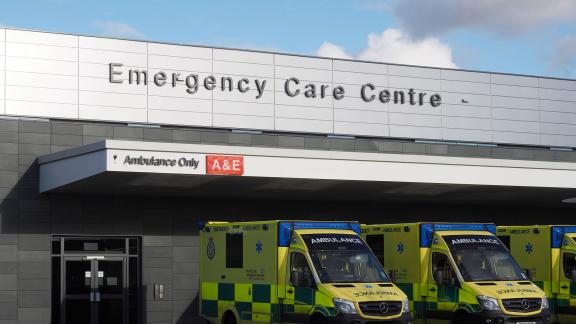Is the left shift mission impossible?

The NHS has had a long history of bold policy ambitions, but few have proved harder to achieve that shifting care from hospitals to the community. While there is widespread agreement that the left shift is the right prescription, the reality is that successive governments have failed to turn rhetoric into reality.
In this long read, our community care leads Jack Sansum and Ant Tucker explore the current policy environment and spotlight the breadth of models and approaches shifting resources and funding flows closer to home.
The term ‘left shift’ remains under debate, not least within NHS policy circles. We define the term as the shift of activity out of hospitals to those delivered closer to home – largely provided by primary or community services and wider system partners.
How did we get here?
Sixteen years separate Lord Darzi’s first review and his most recent investigation of the NHS. Both reviews make the same fundamental diagnosis: while population health needs of have changed, service provision has not. The NHS operating model remains focused on late-stage treatments rather than early intervention or preventing ill health. This approach places a greater burden on NHS resources and does not deliver the best outcomes for patients.
Both reviews state that primary and community settings should provide a greater proportion of NHS activity. Yet, since 2006 the proportion of the NHS budget committed to community services and public health grants has dropped. In the same period, the share devoted to hospitals has continued to grow, from 47 per cent then to 58 per cent today. This trend has also been replicated at a system level.
This means that the NHS has experienced a ‘right drift’, not a left shift: the opposite of its stated strategy. As Lord Darzi states:
“At the highest level, the NHS has had the strategic intention to shift spending from reactive care in hospitals to more proactive care in the community setting – but care has in fact moved in the other direction”.
Despite the government’s ambition to move ‘from hospital to community’, the direction of travel remains the same. By removing many ringfences within NHS budgets, the 2025/26 planning guidance will result in a circa 4 per cent real-terms reduction in spending by many sectors, including community services. Unlike mental health, there is currently no investment standard that protects the funding of the community sector. To start shifting the proportion of the NHS budget towards primary and community care by the end of this parliament, there is a need to develop a metric to incentivise organisations and systems to shift spending from hospitals to more preventative community and primary care.
If left unchecked the right drift will continue
Additionally, the government has decided to increase activity in hospitals to cut acute elective waiting times, which it is continuing to use as its chief measure of NHS performance. This is a consequence of the exclusion of primary, community and mental health waiting times from NHS constitutional standards. If left unchecked the right drift will continue.
Yet against this challenging backdrop – with growing demand for services and budgets set to remain flat for the foreseeable future – many systems and providers across England are seizing the initiative and starting to shift resources within their own control. Amid the complexities of rebalancing resources at a time of squeezed budgets, they are already proving what the left shift can achieve.
From rhetoric to reality: five principles of the left shift
It begs the question: what is the ‘secret sauce’? In examining successful models already in operation today, we spotted common principles that are enabling local leaders to lead and giving them agency to innovate and use scarce resources to best effect.
We spoke with leaders from organisations across the NHS directly involved with transforming services – such as directors of strategy and chief financial officers – to delve deeper. From providers to trusts and systems, each covered different populations with a wide range of needs and assets. Despite their differences, five defining features became evident, which are shaping and driving forward the elusive left shift within their system.
A strong role for systems
Systems made a strong contribution to the models of successful left shift we explored. In many, the integrated care board (ICB) took the lead. North Central London, for example, established a core offer that standardised and brought together previously inconsistent services across its component boroughs. This was then expanded to take in functions based previously in hospitals, thereby shifting resources earlier in care pathways.
In other areas, the system has acted as a key convenor, bringing stakeholders together. The development of the new Midlands Metropolitan Hospital (part of Sandwell and West Birmingham NHS Trust) involved drawing in both adult social care and primary care networks with the assistance of Black Country ICB.
Kent and Medway ICB has played a similar role as part of Dartford and Gravesham NHS Trust’s ongoing efforts to shift more services into the community. Meanwhile, in Lincolnshire the system has used its population mapping capabilities to allow its sole acute trust to better align resources to patient need.
Clinical and managerial alignment
Building consensus between clinical and managerial staff also emerged as a common theme. Although differing in levels of complexity, the examples we examined showed the possibilities that a common purpose could achieve. East London NHS Foundation Trust, for example, noted the enthusiasm with which executive members of staff came onboard with the changes they proposed in mental health services – ensuring that consultants were then able to drive forward change at pace.
Likewise, Dartford and Gravesham NHS Trust outlined the role of clinicians in making service transformation happen: their moral authority gave the left shift added impetus and reinforced the growing consensus. The process of change, too, mattered. North Central London used open-format workshops to develop a shared vision across its workforce, while the risk-stratification of diabetes cohorts by consultants allowed United Lincolnshire Hospitals to close three wards and shift those resources within the same care pathway.
Responsive, flexible financing
One stumbling block encountered by many has been the internal payment mechanisms that connect different parts of the NHS. When interviewed leaders highlighted how rules around lease capitalisation held back the development of community health centres, as well as the difficulties encountered when trying to access multiple funding pots for a single project. Another key question around managing finances was how to demonstrate the immediate returns required by single-year budgets, which could obscure the longer-term benefits of pursuing the left shift.
Nonetheless, where the left shift is taking place leaders have developed imaginative solutions to these challenges. East London NHS Foundation Trust has used Mental Health Investment Standard (MHIS) monies to enable extensive joint working with the voluntary sector.
Meanwhile, Walsall Together’s comprehensive section 75 agreement with local government has given it a central role in adult social care provision, accelerating discharge from hospital and enabling a greater focus on preventative care closer to home. Given the government’s stated intention of reforming adult social care – in part, to improve integration – this model may be examined further.
Patient-centred service design
Another key principle was the centrality of the patient and their needs. For many leaders, improving the patient experience and their clinical outcomes was more important than achieving cost savings – although this was an important factor when earning buy-in from other colleagues. United Lincolnshire Hospitals emphasised the value of empowering the population they serve, for example, allowing the trust to seek help early through pharmacies wherever possible.
Autonomy, similarly, lies at the heart of the new model of mental health care developed in East London. Inspired by the approach pioneered in Trieste and seeking to maximise patients’ freedom, the transformed services on offer are also putting the left shift into action. Meanwhile, a key motivator behind the creation of women’s health hubs in North East London (in partnership with Barts Health Trust) has been improved patient safety. With many in their population speaking English as a second language, providing more gynaecological care in the community has both enabled better patient-clinician communication as well as shifting resources out of hospitals.
Measuring what has changed
But how do we know if the left shift is succeeding? Any attempt to answer this question will require metrics and targets.
With leaders highlighting the importance of buy-in from acute trusts – due to their dominant financial clout in most systems – those settings are often the focus of the metrics chosen to demonstrate the shift. This includes tools that, for example, can capture the number of acute bed-days that left-shifting resources can save – or has saved already.
In a similar way, Sandwell and West Birmingham’s success in pursuing the left shift as part of the development of the Midlands Metropolitan Hospital is measurable in the 10 per cent drop in A&E attendances recorded. As a result, rather than having to open three additional acute wards, the trust has been able to invest instead in additional intermediate and home care through the Better Care Fund (BCF). Primary Care Right Access First Time (RAFT) metrics have also informed this approach, as part of the growth in integrated neighbourhood teams locally.
Elsewhere, leaders are using other metrics to measure the left shift and to demonstrate its impact. Women’s health hubs, as created by North East London ICS through the system’s work with Barts Health Trust, have allowed the proportion of gynaecological consultations taking place outside of hospitals to grow from 15 per cent to 70 per cent of the total. In the process, waiting times have dropped from 18 months to 12 weeks.
Lastly, anecdotal measurement can also have a certain value. When interviewed, some leaders reported positively that – thanks to transforming services and shifting more care into the community – they had opened much less additional clinical space this winter to cope with seasonal pressures than in previous years.
Where next for the left shift?
Meeting the government’s ambition to bring care closer to home will need the whole NHS and its wider system partners, including VCSEs and local government, to support a shift in resources. Reversing the ‘right drift’ of funding into acute hospitals and refocusing the NHS on early intervention through primary and community care is a huge challenge. Success has eluded multiple governments for almost three decades.
But at the same time, the left shift is essential. An ageing population, and the growth of long-term conditions, is showing the traditional model of hospital-centric care to be increasingly unsustainable. Instead of being able to make single, large-scale interventions on occasion in our lives, more and more of us are looking to the NHS to manage our complex health needs for decades to come.
Instead of enforcing a one-size-fits-all model of left shift from the centre, the themes identified here can provide a less prescriptive, more descriptive guide to change
Yet the scale of this challenge, made greater by the prospect of flat budgets for years ahead, a left shift is not impossible. Leaders at every level of the NHS in England are pressing ahead with the left shift to improve their services while reconciling the twin pressures of limited resources with growing demand.
With the ten-year health plan due for publication in the coming months, empowering leaders to pursue the left shift will form a key part of its package of reforms. Instead of enforcing a one-size-fits-all model of left shift from the centre, the themes identified here can provide a less prescriptive, more descriptive guide to change.
A strong role for systems, consensus between clinical and managerial staff, flexible, imaginative financing, keeping patients at the heart of change, and the development of robust metrics to assess and demonstrate the benefits of the left shift are the key principles that underpin the shift's success. With support from the centre – such as via reformed payment mechanisms and improved data quality – NHS leaders can ensure the left shift runs right through the entire health system.
Taking a closer look at what the left shift can achieve
North East London Integrated Care System
North East London ICS (in partnership with Barts Health) created women’s health hubs (WHH) to move services away from secondary care and into the community. The focus was on clinical collaboration and breaking down silos to improve patient safety, reduce waiting times and address unmet need.
With many in the population speaking English as a second language, providing more gynaecological care in the community has both enabled better patient-clinician communication as well as shifting resources out of hospitals. The proportion of gynaecological consultations taking place outside of hospitals has risen from 15 per cent to 70 per cent of the total. In the process, waiting times have dropped from 18 months to 12 weeks. Qualitative feedback of this shift from acute to community has also been positive from patients and staff alike.
A key challenge has been outdated funding and commissioning structures, highlighting the limitations of the purchaser-provider model. Securing collaborative funding rather than project-specific allocations is essential for sustainability. Despite this, funding has been secured until 2027, with a fully established workforce and a maturing model.
Strengthening GP-consultant collaboration remains a priority to support the continued left shift of care, ensuring a holistic approach based on patients' overall health needs. The model is seen as replicable, with single points of access for patients and effective triage by a joint consultant-GP team. Communicating these decisions back to patients in a clear manner forms part of the fundamental components in putting the left shift into action.
United Lincolnshire Hospitals NHS Trust
In Lincolnshire, population mapping has allowed United Lincolnshire Hospitals NHS Trust (ULHT) to better align resources with patient need, in an area with varying levels of deprivation and long-term conditions. This aims to create a responsive urgent care system, strong acute services and a fully integrated out-of-hospital model.
Lincolnshire previously spent £800 million on acute care and only £200 million on community care. To address this imbalance, a Community Alliance was created to shift £300 million worth of services from hospitals into the community. Care is being restructured so the community sector and pharmacies can become the first point of contact for urgent health needs, freeing up GPs to focus on long-term patient management.
Additionally, some specialist services are being moved out of hospitals and into community settings to improve access and efficiency. The risk-stratification of diabetes cohorts by consultants has also allowed United Lincolnshire Hospitals to close three wards and shift those resources within the same care pathway.
Alongside this, a neighbourhood model was developed on primary care network (PCN) footprints as these hold the long-term relationships with patients and serve as the main coordinators of long-term health. With the 2025/26 planning guidance including a dedicated publication on the role of neighbourhoods for the first time, Lincolnshire’s work at this scale may serve as a model for others to follow.
Dartford and Gravesham NHS Trust
Dartford and Gravesham NHS Trust (DGT), working in partnership with Kent and Medway ICB, has focused on shifting care for high-intensity users with complex comorbidities (especially frailty) into the community. Strong relationships between clinical and managerial leadership – as well as between trust and system – have proven crucial in transforming services.
This has involved expanding home visits, community nursing, linking to adult social care with extended hours, and developing capabilities within PCNs. Joint roles are connecting organisations at an operational level, while DGT has invested in integrated acute/community virtual wards to eliminate unnecessary duplication.
Recruitment, commissioning and data sharing have all posed challenges throughout the process. Nonetheless, initial signs are encouraging, with DGT needing to open fewer extra beds this winter than expected despite high levels of seasonal illnesses nationwide. Further monitoring and assessment are ongoing to accurately capture the full impact of shifting resources left.
East London NHS Foundation Trust
East London NHS Foundation Trust (ELFT) is shifting resources to transition mental health services from inpatient settings into the community across Tower Hamlets. The project is built on principles of rights and liberties, ensuring individuals receiving mental health support are integrated within society rather than separated.
The initiative represents a more preventative model of care, placing mental health on equal footing with physical health. It establishes accessible community hubs within PCNs that are a familiar space for patients. These hubs are reinforced by social care and voluntary sector organisations to reach those who typically do not engage with mental health services. Importantly, services extend beyond standard 9–5 hours in collaboration with Look Ahead, a charitable organisation providing supported housing.
This follows an ‘invest to save’ model, generating long-term savings by reducing inpatient bed costs and streamlining patient flow. Although existing mental health legislation and a risk-adverse approach to managing mental health within the community has posed some challenges, with support from the system level ELFT has succeeded in building consensus both within their ranks and also with a wide range of partners in the third sector.
Seed funding from NHS England, however, was essential to making this transformation possible. Likewise, funding through the Mental Health Investment Standard ensured that ELFT could renumerate its not-for-profit partners as required, further strengthening these essential relationships.
North Central London Integrated Care System
North Central London Integrated Care System (NCL) has implemented a core offer to unify previously inconsistent community services across its boroughs. This initiative is aimed at shifting resources earlier in care pathways away from acute settings to community and out-of-hospital care, reducing reliance on hospital-based care and improving overall system efficiency.
With financial flows historically centred around acute trusts, the system examined the consequences of failing to shift resources, particularly given the increasingly challenging financial backdrop. NCL therefore committed to equalising and expanding its existing community services, building consensus across its workforce - as well as local authority representatives – through open workshops for both clinical and managerial staff alike.
To find out more about our work to support members to deliver the government’s ambition to deliver more care closer to home, please contact Jack Sansum.





